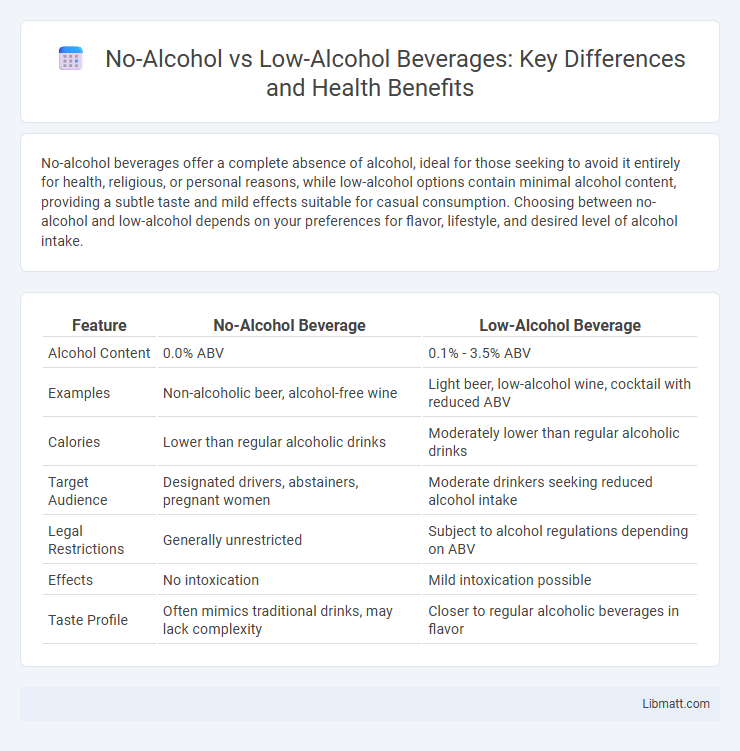No-alcohol beverages offer a complete absence of alcohol, ideal for those seeking to avoid it entirely for health, religious, or personal reasons, while low-alcohol options contain minimal alcohol content, providing a subtle taste and mild effects suitable for casual consumption. Choosing between no-alcohol and low-alcohol depends on your preferences for flavor, lifestyle, and desired level of alcohol intake.
Table of Comparison
| Feature | No-Alcohol Beverage | Low-Alcohol Beverage |
|---|---|---|
| Alcohol Content | 0.0% ABV | 0.1% - 3.5% ABV |
| Examples | Non-alcoholic beer, alcohol-free wine | Light beer, low-alcohol wine, cocktail with reduced ABV |
| Calories | Lower than regular alcoholic drinks | Moderately lower than regular alcoholic drinks |
| Target Audience | Designated drivers, abstainers, pregnant women | Moderate drinkers seeking reduced alcohol intake |
| Legal Restrictions | Generally unrestricted | Subject to alcohol regulations depending on ABV |
| Effects | No intoxication | Mild intoxication possible |
| Taste Profile | Often mimics traditional drinks, may lack complexity | Closer to regular alcoholic beverages in flavor |
Understanding No-Alcohol and Low-Alcohol: Key Definitions
No-alcohol beverages contain less than 0.05% alcohol by volume, making them effectively alcohol-free and ideal for those avoiding intoxication entirely. Low-alcohol drinks have a higher alcohol content, typically between 0.5% and 1.2% ABV, offering a mild alcoholic experience while reducing caloric intake. Understanding these definitions helps consumers make informed choices based on alcohol content and personal health preferences.
The Science Behind Alcohol Reduction
No-alcohol and low-alcohol beverages undergo distinct fermentation and filtration processes to reduce ethanol content while preserving flavor complexity. Advanced techniques such as vacuum distillation, reverse osmosis, and arrested fermentation enable manufacturers to control alcohol levels precisely without compromising taste. Understanding the biochemical reactions involved helps you make informed choices about the balance between alcohol content and sensory experience.
Health Benefits: No-Alcohol vs Low-Alcohol Options
No-alcohol beverages eliminate the risks associated with ethanol consumption, supporting better liver health and reducing calorie intake, which benefits weight management and overall wellness. Low-alcohol options contain minimal alcohol, offering a moderate alternative that may still affect blood pressure and liver function but with less intensity than regular alcohol. Choosing no-alcohol drinks can enhance your health by avoiding alcohol-related issues while still allowing you to enjoy social occasions.
Flavor Profiles and Taste Experiences
No-alcohol beverages typically preserve the original flavor profiles of traditional drinks without the bitterness or warmth from ethanol, offering crisp and refreshing taste experiences suitable for all palates. Low-alcohol options contain 0.5% to 1.2% ABV, providing subtle fermentation notes and a hint of alcohol warmth that enhances complexity and mimics the mouthfeel of regular alcoholic beverages. Flavor profiles in both categories emphasize natural ingredients, balanced sweetness, and aromatic nuances to satisfy consumers seeking sophisticated, guilt-free drinking experiences.
Popularity and Market Trends Worldwide
No-alcohol beverages are gaining significant popularity worldwide, driven by increasing health consciousness and changing consumer lifestyles. The low-alcohol market also shows steady growth, fueled by demand for flavorful options with reduced alcohol content, especially in Europe and North America. Market trends highlight the rise of innovative product offerings and expanded distribution channels to meet diverse consumer preferences.
Social and Cultural Perspectives
No-alcohol beverages are often embraced in cultures with strict social or religious norms against alcohol consumption, supporting inclusion and adherence to these values during social gatherings. Low-alcohol drinks serve as a cultural compromise, allowing moderation while maintaining the ritualistic aspect of drinking in social events. Both options can reduce stigma, promote responsible behavior, and adapt to evolving societal attitudes towards health and wellness.
Choosing the Right Option for Your Lifestyle
Choosing between no-alcohol and low-alcohol beverages depends on your lifestyle goals, such as health, social settings, and taste preferences. No-alcohol drinks offer zero alcohol content, ideal for those seeking complete abstinence, while low-alcohol options provide a lighter alternative that still retains some traditional flavors. Assessing factors like calorie intake, occasion suitability, and personal tolerance helps you select the best choice for balanced enjoyment and well-being.
Impact on Mental Wellbeing
No-alcohol beverages eliminate the risk of alcohol-induced mental health issues such as anxiety and depression, promoting clearer cognitive function and emotional stability. Low-alcohol drinks contain minimal ethanol, which may slightly affect mood but generally pose a reduced risk of impairing mental wellbeing compared to regular alcohol. Choosing no-alcohol or low-alcohol options can support your mental clarity and reduce the likelihood of alcohol-related mental distress.
Regulations and Labeling Differences
No-alcohol beverages typically contain less than 0.05% alcohol by volume (ABV) and are often regulated similarly to non-alcoholic products, while low-alcohol beverages usually have an ABV ranging from 0.5% to 1.2%, subjecting them to more stringent alcohol regulations. Labeling requirements differ, with no-alcohol drinks often allowed to be marketed as "alcohol-free" or "zero alcohol," whereas low-alcohol products must clearly state their alcohol content to comply with legal standards. Your understanding of these distinctions helps ensure compliance with regional laws and accurate consumer information.
Future Innovations in Alcohol-Free and Low-Alcohol Beverages
Future innovations in alcohol-free and low-alcohol beverages focus on enhancing flavor profiles and improving fermentation techniques to mimic traditional alcoholic drinks more closely. Advances in biotechnology and natural ingredients enable the creation of drinks with complex aromas and balanced tastes that cater to health-conscious consumers. Your choices will soon include a wider range of sophisticated options that deliver satisfaction without the effects of alcohol.
No-alcohol vs low-alcohol Infographic

 libmatt.com
libmatt.com